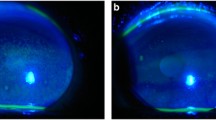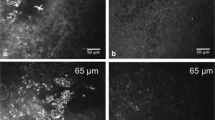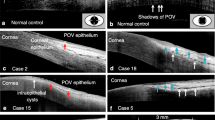Abstract
Background
The aim of this work is to compare the microstructure of cornea verticillata in Fabry disease with amiodarone-induced keratopathy by means of in vivo confocal laser-scanning microscopy (CLSM).
Methods
Ten eyes of ten patients suffering from Fabry disease, six eyes of six patients with amiodarone-induced keratopathy and eight eyes of healthy control subjects were examined by conventional slit-lamp microscopy and CLSM. One Fabry patient received amiodarone therapy. All Fabry patients were under enzyme replacement therapy with agalsidase alfa.
Results
Seven out of ten Fabry patients and all patients receiving amiodarone showed typical cornea verticillata on slit-lamp examination. CLSM revealed hyper-reflective intracellular inclusions in basal epithelial cells of all Fabry patients with cornea verticillata and in one Fabry patient without slit-lamp-detectable vortex keratopathy, as well as in all eyes featuring amiodarone keratopathy. Amiodarone deposits were more reflective and of grossly different size. Seven Fabry patients and all amiodarone patients had stromal microdots. Two amiodarone patients showed amiodarone inclusions in the endothelium. The number of CLSM changes in Fabry patients did not correlate with that of slit-lamp detectable cornea verticillata.
Conclusions
While Fabry-induced cornea verticillata and amiodarone keratopathy cannot be distinguished by conventional slit-lamp microscopy, CLSM allows the differentiation between both etiologies in the majority of patients. CLSM appears to reveal corneal changes prior to the detection of cornea verticillata on slit-lamp microscopy and may thus be helpful in the early diagnosis of Fabry disease. CLSM does not allow quantitative monitoring of corneal changes in Fabry patients under enzyme-replacement therapy.





Similar content being viewed by others
References
Fleischer B (1910) Über eine eigenartige bisher nicht bekannte Hornhauttrübung Albrecht Von. Graefes Arch Ophthalmol 77:136–140
Franceschetti AT (1968) La cornea verticillata et ses relations avec la maladie de Fabry. Ophthalmologica 156:232–238
Vom Dahl S, Wendel U, Strohmeyer G (2006) Genetisch bedingte Stoffwechselerkrankungen. Behandlung, Kosten, sozial-medizinische Aspekte. Deutsche Ärzte-Verlag Köln
Samiy N (2008) Ocular features of Fabry disease: diagnosis of a treatable life-threatening disorder. Surv Ophthalmol 53(4):416–23
Spada M, Pagliardini S, Yasuda M, Tukel T, Thiagarajan G, Sakuraba H, Ponzone A, Desnick RJ (2006) High incidence of later-onset Fabry disease revealed by newborn screening. Am J Hum Genet 79(1):31–40
Tsutsumi A, Uchida Y, Kanai T, Tsutsumi O, Satoh K, Sakamoto S (1984) Corneal findings in a foetus with Fabry's disease. Acta Ophthal (Copenh) 62(6):923–931
Hollander DA, Aldave AJ (2004) Drug-induced corneal complications. Curr Opin Ophthalmol 15(6):541–548
Greene HL, Graham EL, Werner JA, Sears GK, Gross BW, Gorham JP, Kudenchuk PJ, Trobaugh GB (1983) Toxic and therapeutic effect of amiodarone in the treatment of cardiac arrhythmias. J Am Coll Cardiol 2(6):1114–1128
Ucakhan ÖÖ, Kanpolat A, Yilmaz N, Özkan M (2005) Amiodarone keratopathy. An in vivo confocal microscopy study. Eye Contact Lens 31(4):148–157
Orlando RG, Dangel ME, Schaal SF (1984) Clinical experience and grading of amiodarone keratopathy. Ophthalmol 91(10):1184–1187
Stave J, Zinser G, Grümmer G, Guthoff R (2002) Der modifizierte Heidelberg-Retina-Tomograph HRT. Erste Ergebnisse einer In-vivo-Darstellung von kornealen Strukturen. Ophthalmol 99:276–280
Falke K, Büttner A, Schittkowski M, Stachs O, Kraak R, Zhivov A, Rolfs A, Guthoff R (2009) The microstructure of cornea verticillata in Fabry disease and amiodarone-induced keratopathy: a confocal laser-scanning microscopy study. Graefes Arch Clin Exp Ophthalmol 247(4):523–534
Nguyen TT, Gin T, Nicholls K, Low M, Galanos J, Crawford A (2005) Ophthalmological manifestations of Fabry disease: a survey of patients at the Royal Melbourne Fabry Disease Treatment Centre. Clin Experiment Ophthalmol 33(2):164–8
Ciancaglini M, Carpineto P, Zuppardi E, Nubile M, Doronzo E, Mastropasqua L (2001) In vivo confocal microscopy of patients with amiodarone-induced keratopathy. Cornea 20(4):368–373
Weingeist TA, Blodi FC (1971) Fabry´s disease: ocular findings in a female carrier. Arch Ophthalmol 85(2):169–76
Seiler KU, Thiel HJ, Wassermann O (1977) Die chloroquinkeratopathie als Beispiel einer arzneimittelinduzierten Phopholipidosis. Klin Monbl Augenheilkd 170(1):64–73
Mastropasqua L, Nubile M, Lanzini M, Carpineto P, Toto L, Ciancaglini M (2006) Corneal and conjunctival manifestations in Fabry disease: in vivo confocal microscopy study. Am J Ophthalmol 141(4):709–718
Author information
Authors and Affiliations
Corresponding author
Additional information
The authors are not supported by, nor maintain any financial interest in, any commercial activity that may be associated with the topic of this article.
Electronic supplementary material
Below is the link to the electronic supplementary material.
ESM 1
(DOC 28 kb)
Rights and permissions
About this article
Cite this article
Wasielica-Poslednik, J., Pfeiffer, N., Reinke, J. et al. Confocal laser-scanning microscopy allows differentiation between Fabry disease and amiodarone-induced keratopathy. Graefes Arch Clin Exp Ophthalmol 249, 1689–1696 (2011). https://doi.org/10.1007/s00417-011-1726-5
Received:
Revised:
Accepted:
Published:
Issue Date:
DOI: https://doi.org/10.1007/s00417-011-1726-5




